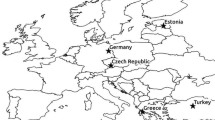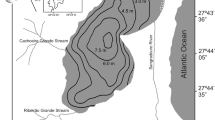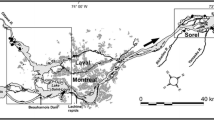Abstract
The marked spatial variation in periphyton could reflect differences in exposure, grazing or substratum. To determine if any of these factors was significant, I studied the relationship between the degree of exposure to waves (measured as fetch), grazing intensity (measured as invertebrate biomass) and spatial variation in periphyton biomass in sites of similar substratum along an island in the central mesotrophic basin of Lake Memphremagog (Québec). In spring, there was a positive relationship between fetch and periphyton biomass both on stones and on artificial substrata. This effect was especially strong for diatoms, for algae between 100–1000 µm3, for planktonic forms and for filamentous and long-stalked species. In spring, water renewal encouraged growth of these forms, but the effect disappeared in summer, coincident with silica depletion. Grazers, which were not important in the spatial variation observed in spring, probably contributed to the sudden decline of periphyton in the exposed sites in summer. Observations in nearby lakes indicate that these patterns may be general.
Similar content being viewed by others
References
Barton, D. R. & J. C. H. Carter, 1982. Shallow-water epilithic invertebrate communities of eastern Georgian Bay, Ontario, in relation to exposure to wave action. Can. J. Zool. 60: 984–993.
Beach Erosion Board, 1972. Waves in inland reservoirs. U.S. Army Corps Eng., Beach Erosion Bd Tech. Memo 132.
Bergman, M. & R. H. Peters, 1980. A simple reflectance method for the measurement of particulate pigment in lake water, and its application to phosphorus-chlorophyll-seston relationships. Can. J. Fish. aquat. Sci. 37: 111–114.
Brown, S. D. & A. P. Austin, 1973. Spatial and temporal variation in periphyton and physico-chemical conditions in the littoral of a lake. Arch. Hydrobiol. 71: 181–232.
Castenholz, R. W., 1961. An evaluation of a submerged glas method of estimating production of attached algae. Verh. int. Ver. Limnol. 14: 155–159.
Cattaneo, A., 1983. Grazing on epiphytes. Limnol Oceanogr. 28: 124–132.
Cattaneo, A., 1987. Periphyton in lakes of different trophy. Can. J. Fish. aquat. Sci. 44: 296–303.
Cattaneo, A. & J. Kalff, 1978. Seasonal changes in the epiphyte community of natural and artificial macrophytes in Lake Memphremagog (Que. & Vt.). Hydrobiologia 60: 135–144.
Chambers, P. A., 1987. Nearshore occurrence of submersed aquatic macrophytes in relation to wave action. Can. J. Fish. aquat. Sci. 44: 1666–1669.
Cox, E. J., 1988. Has the role of substratum been under estimated for algal distribution patterns in freshwater ecosystems. Biofouling 1: 49–63.
Dillon, P. J. & F. H. Rigler, 1974. The phosphorus-chlorophyll relationship in lakes. Limnol. Oceanogr. 19: 767–773.
Duarte, C. M. & J. Kalff, 1986. Littoral slope as a predictor of the maximum biomass of submerged macrophyte communities. Limnol. Oceanogr. 31: 1072–1080.
Fox, J. L., T. O. Olaug & T. A. Olson, 1969. The ecology of periphyton in Western Lake Superior. 1. Taxonomy and distribution. Bull. Water Resour. Res. Cent. Univ. Minn. 14: 1–97.
Hakanson, L., 1981. A manual of lake morphometry. Springer-Verlag. New York, NY, 78 pp.
Hoagland, K. H., 1983. Shot-term standing crop and diversity of periphytic diatoms in a eutrophic reservoir. J. Phycol. 19: 30–38.
Horner, R. R. & E. B. Welch, 1981. Stream periphyton development in relation to current velocity and nutrients. Can. J. Fish. aquat. Sci. 38: 449–457.
Kairesalo, T., 1983. Dynamics of epiphytic communities on Equisetum fluviatile L.: Response to short-term variation in environmental conditions. In R. G. Wetzel (ed.), Periphyton of freshwater ecosystems. Hydrobiologia/Dev. Hydrobiol. 17: 153–160.
Keddy, P. A., 1982. Quantifying within-lake gradients of wave energy: Interrelationships of wave energy, substrate particle size and shoreline plants in Axe Lake, Ontario. Aquat. Bot. 14: 41–55.
Komar, P. D., 1976. Beach processes and sedimentation. Prentice Hall, Englewood Cliffs, N.J. 429 pp.
Lamberti, G. A/ & V. H. Resh, 1983. Stream periphyton and insect herbivores: an experimental study of grazing by a caddisfly population. Ecology 64: 1124–1135.
Liaw, W. K. & H. R. MacCrimmon, 1978. Assessing changes in biomass of riverbed periphyton. Int. Revue ges. Hydrobiol. 63: 155–171.
Lock, M. A. & P. H. John, 1979. The effect of flow pattern on uptake of phosphorus by river periphyton. Limnol. Oceanogr. 24: 376–383.
Loeb, S. L., 1981. An in situ method for measuring the primary productivity and standing crop of the epilithic periphyton community in lentic systems. Limnol. Oceanogr. 26: 394–399.
Lund, J. W., 1964. Primary production and periodicity of phytoplankton. Verh. int. Ver. Limnol. 15: 37–56.
McCauley, E., 1984. The estimation of the abundance and biomass of zooplankton in samples. In J. A. Downing and F. H. Rigler (eds.), A manual on methods for the assessment of secondary productivity in freshwater. Blackwell Scientific Publications, Oxford: 228–265.
McIntire, C. D., 1966. Some effect of current velocity on periphyton communities in laboratory streams. Hydrobiologia 27: 559–570.
Menzel, D. W. & H. Corwin, 1965. The measurement of total phosphorus based on the liberation of organically bound fractions by persulfate oxidation. Limnol. Oceanogr. 10: 280–282.
Newcombe, C. L., 1950. A quantitative study of attachment materials in Sodon Lake, Michigan. Ecology 31: 204–215.
Pennak, R. W., 1978. Fresh-water invertebrates of the United States. J. Wiley & Sons. New York. 803 pp.
Pieczynska, E., 1965. Variation in the primary productivity of plankton and periphyton in the littoral zone of lakes. Bull. Acad. Pol. Sci. 13: 219–225.
Reuter, J. E., S. L. Loeb & C. R. Goldman, 1986. The physiological ecology of nuisance algae in an oligotrophic lake. In L. V. Evans & K. D. Hoagland (eds.). Algal Biofouling. Elsevier Press, Amsterdam: 115–127.
Reynolds, C. S., 1984. The ecology of freshwater phytoplankton. Cambridge University Press, Cambridge. 384 pp.
Silvester, N. R. & M. A. Sleigh, 1985. The forces on microorganisms at surfaces in flowing water. Freshwat. Biol. 15: 433–448.
Smock, L. A., 1980. Relationships between body size and biomass of aquatic insects. Freshwat. Biol. 10: 375–383.
Strickland, J. D. H. & T. R. Parsons, 1972. A practical handbook of seawater analysis. 2nd. ed. Bull. Fish. Res. Bd Can. 167: 310 pp.
Tanimizu, K., T. Miura & M. Higashi, 1981. Effect of water movement on the photosynthetic rate of an algal community attached to reed stems. Verh. int. Ver. Limnol. 21: 584–589.
Whitford, L. A., 1960. The current effect and growth of freshwater algae. Trans. am. Microsc. Soc. 79: 302–309.
Young, O. W., 1945. A limnological investigation of periphyton in Douglas Lake, Michigan. Trans. am. Microsc. Soc. 64: 1–20.
Author information
Authors and Affiliations
Additional information
Contribution of the Lake Memphremagog Project, Limnology Research Centre.
Rights and permissions
About this article
Cite this article
Cattaneo, A. The effect of fetch on periphyton spatial variation. Hydrobiologia 206, 1–10 (1990). https://doi.org/10.1007/BF00018964
Received:
Revised:
Accepted:
Issue Date:
DOI: https://doi.org/10.1007/BF00018964




